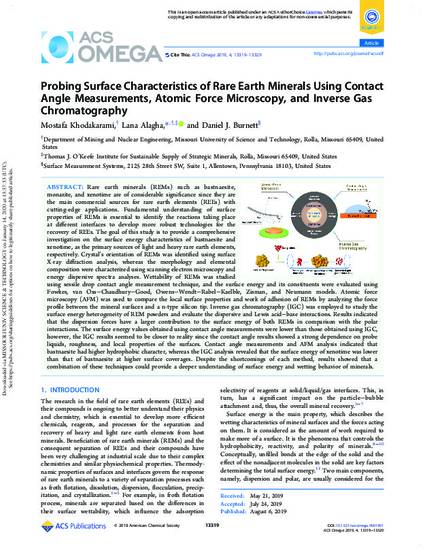
Rare earth minerals (REMs) such as bastnaesite, monazite, and xenotime are of considerable significance since they are the main commercial sources for rare earth elements (REEs) with cutting-edge applications. Fundamental understanding of surface properties of REMs is essential to identify the reactions taking place at different interfaces to develop more robust technologies for the recovery of REEs. The goal of this study is to provide a comprehensive investigation on the surface energy characteristics of bastnaesite and xenotime, as the primary sources of light and heavy rare earth elements, respectively. Crystal's orientation of REMs was identified using surface X-ray diffraction analysis, whereas the morphology and elemental composition were characterized using scanning electron microscopy and energy dispersive spectra analyses. Wettability of REMs was studied using sessile drop contact angle measurement technique, and the surface energy and its constituents were evaluated using Fowkes, van Oss-Chaudhury-Good, Owens-Wendt-Rabel-Kaelble, Zisman, and Neumann models. Atomic force microscopy (AFM) was used to compare the local surface properties and work of adhesion of REMs by analyzing the force profile between the mineral surfaces and a n-type silicon tip. Inverse gas chromatography (IGC) was employed to study the surface energy heterogeneity of REM powders and evaluate the dispersive and Lewis acid-base interactions. Results indicated that the dispersion forces have a larger contribution to the surface energy of both REMs in comparison with the polar interactions. The surface energy values obtained using contact angle measurements were lower than those obtained using IGC, however, the IGC results seemed to be closer to reality since the contact angle results showed a strong dependence on probe liquids, roughness, and local properties of the surfaces. Contact angle measurements and AFM analysis indicated that bastnaesite had higher hydrophobic character, whereas the IGC analysis revealed that the surface energy of xenotime was lower than that of bastnaesite at higher surface coverages. Despite the shortcomings of each method, results showed that a combination of these techniques could provide a deeper understanding of surface energy and wetting behavior of minerals.
Available at: http://works.bepress.com/lana-alagha/20/
